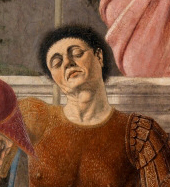Once upon a time, in a fascinating corner of Renaissance Italy, there was a genius who would leave an indelible mark on the history of art: Piero della Francesca. Born in an era of cultural ferment, when humanism was redefining the boundaries of knowledge, Piero distinguished himself for his unique ability to blend art with mathematics, creating works that still today arouse admiration and amazement.
More surprising than a charade, more fascinating than a historical novel, his life represents an extraordinary journey through mystery, creativity and scientific rigour. If you are ready to discover a world where geometry meets painting and the Renaissance comes to life in the hands of a genius, then get ready to dive into the universe of Piero della Francesca.
The birth of a genius
To fully understand the figure of Piero della Francesca, we need to start from his roots. Piero was born in Sansepolcro, known at the time as ‘Borgo San Sepolcro’, on an uncertain date between 1406 and 1416.
He grew up in a family that, although not of noble origins, provided him with the basis for a solid education. The son of Benedetto de’ Franceschi and Romana di Pierino da Monterchi, Piero was a special child from birth, which occurred after the death of his father.
This detail led to him being baptised with his mother’s surname, an unusual fact for the time, which already emphasises his uniqueness. The loss of the municipal archives due to a fire has made it difficult to establish the exact year of his birth, but this aura of mystery contributes to making his figure even more fascinating.
Training and early works
Piero’s training took place in the lively cultural environment of Borgo Sansepolcro, a crossroads of artistic influences from Florence, Siena and Umbria. Here, the young Piero began his journey under the guidance of Antonio di Anghiari, a well-known artist in the area. His thirst for knowledge and his extraordinary ability to learn quickly soon took him to Florence, the beating heart of Renaissance art.
In 1439 Piero was documented as an assistant to Domenico Veneziano in the frescoes of the church of Sant’Egidio. It was during this period that Piero assimilated the masterful use of light typical of Veneziano, an element that would characterise all his future works. Alongside this, the influence of Masaccio, with his powerful and innovative painting, helped to shape Piero’s aesthetic, making it unique.
The art and mathematics of Piero della Francesca
What makes Piero della Francesca an exceptional figure in the history of art is his ability to integrate art with mathematics. In his works, the study of perspective becomes a fundamental element, transforming each painting into a perfect representation of three-dimensional space on a two-dimensional surface.
Piero didn’t limit himself to following existing theories of perspective, but he studied and developed them further, contributing significantly to their evolution.
The plastic monumentality of his figures, the skilful use of light to model volumes and create depth, and the geometric simplification of the compositions, are all distinctive features of his art. Each of his paintings is a celebration of balance and harmony, in which mathematical precision is perfectly combined with artistic expression.
The lost and surviving works
Despite Piero’s extraordinary talent, a large part of his artistic production has been lost over the centuries. Among the most significant losses are the frescoes he painted in the Apostolic Palace, which were later replaced by the famous Raphael Rooms in the 16th century.
However, the works that have come down to us represent an inestimable treasure of Renaissance art. Masterpieces such as ‘The Flagellation of Christ’, with its perfect geometric composition, and the cycle of frescoes ‘The Legend of the True Cross’ in the Basilica of San Francesco in Arezzo, bear witness to Piero’s extraordinary skill. Each surviving work offers us a privileged glimpse into his artistic vision, in which every detail is the result of in-depth study and unique sensitivity.
Piero della Francesca: an Aretine story
The life and work of Piero della Francesca are deeply intertwined with the history of Arezzo and its territory. His Aretine origins are not just a biographical fact, but an element that profoundly influenced his artistic career. The cultural and intellectual context in which he grew up, rich in stimuli and influences, helped shape his unique vision of art.
His ability to combine painting with mathematical speculation made him a pioneer, anticipating many of the artistic achievements that would characterise the Renaissance.
Piero della Francesca was not only a painter, but a thinker, mathematician and innovator, whose legacy lives on through his works and the influence he has had on generations of artists. Even today, visiting his works in and around Arezzo is a fascinating journey to discover a genius who was able to transform his vision into immortal art.

